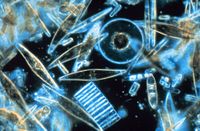
Photo from wikipedia
Temperature change and eutrophication are known to affect phytoplankton communities, but relatively little is known about the effects of interactions between simultaneous changes of temperature and nutrient loading in coastal… Click to show full abstract
Temperature change and eutrophication are known to affect phytoplankton communities, but relatively little is known about the effects of interactions between simultaneous changes of temperature and nutrient loading in coastal ecosystems. Here we show that such interaction is key in driving diatom-dinoflagellate dynamics in the East China Sea. Diatoms and dinoflagellates responded differently to temperature, nutrient concentrations and ratios, and their interactions. Diatoms preferred lower temperature and higher nutrient concentrations, while dinoflagellates were less sensitive to temperature and nutrient concentrations, but tended to prevail at low phosphorus and high N:P ratio conditions. These different traits of diatoms and dinoflagellates resulted in the fact that both the effect of warming resulting in nutrients decline as a consequence of increasing stratification and the effect of increasing terrestrial nutrient input as a result of eutrophication might promote dinoflagellates over diatoms. We predict that conservative forecasts of environmental change by the year 2100 are likely to result in the decrease of diatoms in 60% and the increase of dinoflagellates in 70% of the surface water of the East China Sea, and project that mean diatoms should decrease by 19% while mean dinoflagellates should increase by 60% in the surface water of the coastal East China Sea. This analysis is based on a series of statistical niche models of the consequences of multiple environmental changes on diatom and dinoflagellate biomass in the East China Sea based on 2815 samples randomly collected from 23 cruises spanning 14 years (2002-2015). Our findings reveal that dinoflagellate blooms will be more frequent and intense, which will affect coastal ecosystem functioning.
Journal Title: Water research
Year Published: 2018
Link to full text (if available)
Share on Social Media: Sign Up to like & get
recommendations!